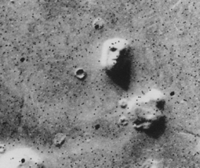Memes and Magical Thinking
There were so many excellent papers at this year’s British Association Festival of Science, that I still haven’t had been able to comment on all of them, but here’s another one that I found interesting for two reasons.
Bruce Hood, who is Professor of Experimental Psychology at the University of Bristol, presented an interesting paper on the near-Universality of superstitious beliefs and magical thinking. In his view people are naturally biased to accept a role for the irrational, and magical thinking is hard-wired into our brains.
Magical thinking is invaluable to an artist: being able to make new connections is the key to their creations. But it has long been argued that either rejecting or accepting magical thinking may both be potential triggers of psychopathology. I once treated a young Israeli man who, during the first Gulf War, became convinced that Saddam Hussein was personally writing the Israeli man’s name on each Scud missile. He refused to remove his gas mask, and eventually his thinking became delusional.
Bruce’s conclusion is that magical thinking and a belief in the supernatural is an evolutionary adaptation. He goes on to argue that the rabid atheists who blame organized religion for the spread “illogical thinking” and a belief in the supernatural and are just plain wrong. Instead he contends that religion may capitalize on a natural bias to assume the existence of supernatural forces.
In a world in which religious fundamentalism is something of a challenge, he had this to say:
“It is pointless to get people to abandon their belief systems because they operate at such a fundamental level that no amount of rational evidence or counter evidence is going to be taken on board to get people to abandon these ideas.”
Bruce has carried out studies to show how the brains of even young babies organize sensory information. They supply what is missing and use the information to generate theories about the world.
In adulthood, the visual centers of the brain still fill in details that are not there, as shown in common visual illusions such as the blind spot. Several years ago we did some experimental work on facial recognition, and it is remarkable how little information is needed to recognize a face: the brain supplies the missing pieces of the picture. This childhood “intuitive reasoning” persists in to adulthood and may explain many aspects of adult magical beliefs. We are programmed to see coincidences as significant and to attribute minds to inanimate objects.
One form of this is known as pareidolia in which vague and random stimuli are misperceived as recognizable patterns. Examples of this are seeing shapes in clouds or in a fire. With the new information from the European Space Agency, perhaps we could include seeing the Face on Mars.

Professor Hood used an interesting example. He offered members of the audience the chance to wear a sweater, for which he would pay them a sum of money. They were all happy to do so, until they heard that it had supposedly belonged to a mass murderer, when suddenly there were no takers. Many said that they felt that the clothing was contaminated with evil.
But I don’t think that Bruce has taken something else into account. According to the theory of spiral dynamics, we are all mixtures of Memes. We tend to associate magical thinking with the Purple Meme. It would be very valuable to look at a person’s developmental level and to see how much he or she engages in magical thinking. Someone once said to me, “Are you superstitious?” I said, “No, but I do understand that there are many forces at work in the Universe, and we do not yet know all of them.”
Are you a magical thinker, or is it that you are aware of the unseen forces of the Universe?
“The universe is full of magical things, patiently waiting for our wits to grow sharper.” –Eden Philpotts (Indian-born English Novelist, Dramatist and Poet, 1862-1960)






